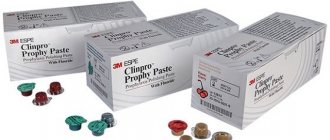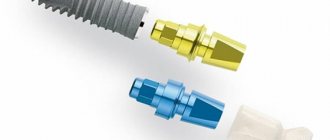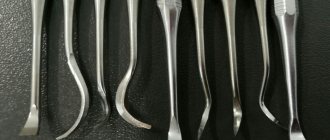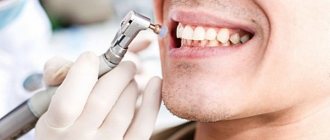Not everyone manages to keep their own teeth throughout their lives. Losing teeth is usually a matter of time. Some people lose their first molar by the age of 20, while others manage to maintain a full set of teeth until retirement. In any case, prosthetics sooner or later becomes relevant for the vast majority of patients.
Removable dentures are usually used in cases where quite a lot of teeth are lost, and the option of restoration with crowns or bridges on implants is not considered. Having a full set of teeth in your mouth is important for more than just aesthetics. Their deficiency affects the shape of the face, diction, and the ability to chew and digest food normally.
What are removable dentures?
The word “prosthesis” can be scary for some patients, especially if they are young. This word is associated with crutches, dentures and the decline of life. In fact, dentures, on the contrary, help restore the aesthetics and joy of comfortable eating. Modern technologies make it possible to make prostheses from high-quality materials. They are miniature, do not rub, do not fall out of the mouth when laughing or sneezing, and do not impair speech. In addition, artificial teeth are perfectly straight and beautiful, just like in the picture in the magazine.
The essence of the prosthesis is that artificial teeth are placed on a base made of high-strength material matching the color of the gums. The structures correctly distribute the chewing load, restore the proper functioning of the dental system and the beauty of the smile.
How is production carried out?
Manufacturing is carried out in a dental laboratory by a dental technician. First, the model of the prosthesis and materials are determined. As a rule, both metal wire and cast hooks are bent using special pliers, pliers and round nose pliers. Then the clasp is included in the base and the entire structure is tried on the patient; if necessary, the product is modified. During the manufacturing process, it is important to comply with the requirements for the manufacture of the shoulder and the implementation of the contact process. Thus, the shoulder should not overload the supporting tooth, but should adhere to the crown at the maximum number of points. The metal is well polished so that the hook does not injure the enamel and does not become a place where plaque accumulates. As for the process, it is bent with round nose pliers and notches are made for better connection with the base.
Indications
There are a number of indications for installing removable dentures:
- Pathological abrasion of teeth.
- Inability to install single crowns or bridges due to lack of sufficient teeth, jaw characteristics or financial aspects.
- Presence of end defect.
- The inability or unwillingness of the patient to restore the dentition with crowns on implants.
- Reluctance to prepare abutment teeth to install bridges.
- Periodontal diseases (chronic periodontitis, periodontal disease).
- The need to wait for other types of prosthetics (as a temporary option).
- The desire to restore teeth quickly and without significant financial investments.
Requirements for hook placement
Denture clasps must be selected in accordance with all of the following requirements:
- the fixation will be the same on all supporting teeth,
- rotation or overturning of the prosthesis is excluded,
- do not overestimate the bite in the presence of occlusal pads,
- do not lead to injury to the teeth (including those of the opposite or antagonistic teeth) when closing the jaws and chewing,
- do not greatly reduce the aesthetics of a smile: metal ones located in the “smile zone” are highly noticeable from the outside, while synthetic ones are less noticeable. But the latter quickly stretch and break more often,
- the supporting teeth do not have pathological mobility,
- crowns of correct anatomical shape and sufficient height (5 mm or more).
You also need to take into account the position of the boundary line - this is the line that divides the crown into supporting and retaining parts. This parameter is determined using a parallelometer device. So, for example, on the lower teeth, the upper part of the clasp (occlusal pad and top of the shoulder) is located above the boundary line, and the lower part of the shoulder falls below the line. On the upper jaw, everything is, accordingly, the opposite.
Preparing for installation
Before using removable prosthetics, as with any type of prosthetics, some preparation is required. It includes:
- Sanitation of the oral cavity. The stage includes the treatment of caries, removal of mobile, damaged and untreatable teeth. Inflammatory processes, if any, are also treated.
- Taking impressions of both jaws. In any case, there are two impressions, so that when making a prosthesis, the correct bite can be maintained, and the prosthesis does not interfere with the patient’s ability to close his jaws normally.
- Making a plaster model. Based on this model, the structure is subsequently manufactured.
- Fitting and correction stage. Fitting is an important part of the process to make wearing as comfortable as possible and avoid damage to soft tissue or supporting teeth.
Types of clasps
Depending on the material, clasps for fixing dentures are:
- Metal.
- Plastic or nylon.
- Metal-plastic.
Metal hooks have the lowest aesthetics. They are visible when talking and smiling. Nylon ones are made in the color of the gums, have the required transparency, due to which they are practically invisible to others. Their disadvantage is the incorrect distribution of the load during chewing. The material is soft and cannot provide the required rigidity (unlike less aesthetically pleasing metal).
Depending on the type of fastening, clasps are of dental, gingival and mixed types. According to the manufacturing method - bent, cast and combined.
Briefly about each of them
- Acrylic dentures. These are the most common and inexpensive prostheses. They are very light, do not require tooth preparation; hooks are used for fastening, covering the patient’s own teeth. The plastic from which they are made can cause allergies only in severe cases, and is used for the vast majority of cases.
- Acrylic-free dentures. From the name it is clear that acrylic is not used in these designs. They better distribute the chewing load, while the material is free of additives that can cause irritation to soft tissues. Acrylic-free dentures are durable and fit well to the gums. If there are teeth, hooks are used for fastening; if not, a system similar to a suction cup is used.
- Nylon systems. This is a traditional option for restoring several teeth, that is, small areas in a row, rather than the entire jaw. Constructions are not used for edentulous patients, since due to their softness they cannot evenly distribute the chewing load, which leads to rapid resorption of bone tissue. In terms of cost, these comfortable soft prostheses are quite expensive in comparison with those described above.
- Clasp dentures. Durable structures with a reduced contact area on the palate and gums. This is achieved due to the thin body. The base is a metal plate, which can be covered with a layer of plastic in the color of the gums. Features are: uniform load distribution, maximum preservation of bone tissue, miniature size. Fastening is carried out using hooks and locks. Due to the presence of metal, the prosthesis can occasionally cause irritation of the mucous membrane.
- Sandwich dentures. These are new generation systems that are located in the mouth without affecting the upper or lower palate. To attach them, it is sufficient for the patient to have two supporting teeth.
- Quadrotti. Nylon-based prostheses, manufactured using the latest Italian techniques. This is a variation of the sandwich system with some special features. The dentures are durable, comfortable, and do not require long getting used to.
Types of dentures on hooks
Hooks help fix different types of prostheses:
- Acrylic dentures. This is the cheapest and most common option. The design consists of an acrylic base with artificial crowns attached to it. Most often, “teeth” are also made of acrylic; crowns made of ceramics are less common. The prosthesis is adjacent to the gum and is additionally secured with hooks. The shade of the base is selected to match the natural color of the patient’s gums. The disadvantage of acrylic is that it does not always look natural due to its opacity. The prosthesis is durable, light and cheap, which is a definite advantage. Disadvantages include poor aesthetics and the need to get used to a rigid and fairly voluminous structure.
- Clasp dentures. More expensive and, undoubtedly, ahead of other prosthetic models in terms of comfort, strength and other indicators. The principle of the structure is the same as that of acrylic ones, but instead of a massive acrylic base, clasp structures have a thin metal plate (on the sides the dentures also have plastic parts in the color of the gums). They are durable and take up much less space in the mouth. The main condition for their installation is the patient’s own teeth on both sides of the jaw. The clasp denture correctly distributes the load when chewing, which allows you to slow down the process of resorption of bone tissue where there are no teeth.
- Nylon prostheses. Partial designs made of nylon with hooks are much less noticeable in the mouth due to the fact that their clasps are made of the same material as the base. Nylon has the desired transparency, making it almost invisible when talking or smiling. Prostheses of this type are comfortable due to their flexibility and softness; they do not rub and do not require a long period of getting used to. There are also disadvantages. The main one is the failure of nylon hooks. They are soft and cannot provide proper load distribution.
Which removable denture is better to install?
The choice of orthopedic design depends on the clinical picture, preferences and financial capabilities of the patient. The main condition is a correctly manufactured prosthesis, which is easy to use and receives sufficient care from the patient. It is also necessary to think about the prospects: if your plans for the future include dental implantation, then it is better to give preference to a prosthesis with a rigid base, which will more correctly distribute the load on the bone tissue, preventing its atrophy.
The average cost of installing removable dentures in Moscow is from 9,000 rubles to 60,000 rubles.
Service life of dentures with hooks
The lifespan of a clasp denture is about five years. Nylon can be used less as it is more flexible and susceptible to deformation. Replacement is required because the fixation strength decreases over time. This occurs due to the gradual resorption of bone tissue and subsequent disruption of the fit of the structure. Due to the fact that clasp dentures correctly distribute the load, the atrophy process is slower. Nylon, due to its softness, allows the process to go faster.
An alternative to clasp fixation is to attach it to locking attachments. Fastening elements are placed on crowns fixed to abutment teeth. Locks allow you to firmly fix the structure.
Author:
Mayorov Andrey Mikhailovich
Specialization:
orthopedic dentistry, dental prosthetics, implant installation
Common clasp designs
- Ney's system: there are 5 types of clasps - Acker, Roach, combined (from Acker and Roach designs), single-arm reverse action, single-arm ring. This system was developed in 1949 with the participation of dentists and engineers. It includes both already known fastenings (modified) and new ones,
- developed by Acker: a supporting-retaining element with a rigid connection, consisting of 2 arms, an occlusal pad and a body. One of the oldest and most famous varieties, which first appeared in 1926,
- Roach: a support-retaining device with an occlusal pad and a spring (elastic) connection, which is easy to distinguish from others - its two arms look like the letter “T”. Because of this similarity, the hook is called “split”. Made from cobalt-chromium and gold-platinum alloys,
- Bonneville: Also known as the “six-arm” because it consists of 4 arms and 2 occlusal pads. Fixes 2 teeth at once,
- Jackson: includes 2 branches and 2 bodies, made of wire,
- Adams: one of the most versatile and effective types, suitable for both free-standing teeth and those included in segments,
- arrow-shaped Schwartz clasp: consists of 1 or 2 links, can also be multi-link. It is made of elastic wire and fits well into the interdental spaces.
%akc72%
Prostheses with push-button fixation –
At the first stage, implants are installed in the jaw, the number of which will depend both on their diameter and on whether prosthetics will be performed on the upper or lower jaw. In the upper jaw, 4 implants are usually installed - regardless of their diameter, which is due to the presence of a softer type of bone in the upper jaw.
On the lower jaw, if mini-implants (1.8-2.4 mm in diameter) are used, 4 of them are also installed. Moreover, the use of implants of such a small diameter allows you to almost always avoid bone grafting - if the patient has thin alveolar shoot. However, if implants with a diameter of 4-5 mm are used, only 2 of them can be installed, but 3-4 are still better, because this will improve the stability of the prosthesis.
Prosthesis fixation system - after installing the implants, abutments are screwed into them, which will protrude above the surface of the mucous membrane and serve as an element for fixing the prosthesis. For these purposes, two types of abutments can be used: spherical or equatorial. Which type of fixation (using which abutments) is better – we explain in detail below.
1) Fixation on ball-shaped abutments –
Below we show a diagram of fixing a removable denture on ball-type abutments. You will find a detailed description below.
After installing the implants, abutments are screwed into them (or the implants may already have permanent abutments). Externally, the spherical abutment looks like a metal ball-shaped head protruding above the mucous membrane (Fig. 4). Such spherical abutments are the first half of the mechanism for fixing a removable denture on implants. The second half of the locking fastening is located in the base of the prosthesis.
In the projection of each implant with a spherical abutment, a recess is made in the base of the prosthesis into which a metal holder for a silicone matrix is inserted, of course, along with the matrix itself. The silicone matrix is something like a rubber sealing ring (Fig. 5). When putting on the prosthesis, the head of the ball-shaped abutment passes through this ring, which then tightly holds the abutment (Fig. 6). After this, the prosthesis can be removed only by applying sufficient force.
Fixation of the prosthesis on ball-shaped abutments: photo
Important: the big disadvantage of the fixation system on ball-shaped abutments is that they tend to wear out as a result of friction in about 2-3 years. As a result, the abutment head becomes flatter and the silicone matrix holds it less and less well. That is why it is worth installing only those implants in which the ball-shaped abutment can be replaced with a new one.
If you install implants that already have permanent abutments, then in order to replace them, you will simply have to install the implants again. To reduce the rate of wear, some companies coat the abutments with special coatings, but this is still not a long-term solution to this problem.
2) Fixation on equatorial abutments (Locator®) –
This fixation system is called Locator® (Fig. 13-15).
For patients, it is more comfortable in terms of removing and putting on a removable denture, and also allows them to visit the dentist less often to service the prosthesis fixation system. It allows implant surgeons to place implants in the jaw at large angles relative to each other, which is necessary in case of severe atrophy of the jaw bone tissue. Equator abutments differ from spherical abutments in their shape, which affects the nature of the interaction between the abutment and the silicone matrix. With this system, a holder for the matrix is also built into the base of the removable denture (along with the silicone matrix itself) - in the projection of each installed implant with an abutment. Equator abutment dentures are more comfortable and require less maintenance.
Fixation of the prosthesis on the equatorial abdomen: photo
Features of prosthetics with prostheses with push-button type of fixation –
The manufacture of a prosthesis, both when using spherical and equatorial abutments, in most cases can be carried out immediately after surgery (especially on the lower jaw). Those. Impressions will be taken immediately and within a few days a prosthesis will be made from either regular acrylic plastic or slightly elastic Acry-free material (this option will be more expensive).
However, if you already have a prosthesis (provided that it is well made and is no more than 2 years old), you will be able to use your old prosthesis without making a new one. To do this, recesses will be made in your old prosthesis and locking fasteners - silicone matrices - will be installed there.
Advantages of push-button type fixation:
- technical ease of manufacture,
- more affordable price,
- implants with push-button fastening can be installed even under an old prosthesis,
- simpler hygiene (less risk of inflammation around implants in the future).
Disadvantages of push-button type locking –
- Weakening of the fixation over time requires periodic replacement of silicone matrices, and in the case of spherical abutments, the matrices will have to be changed several times more often - approximately once every six months (compared to the use of equatorial abutments, where the matrices are changed less frequently).
Overdentures with fixation “Locator”: video
Complications that may arise due to clasps
Negative consequences or complications associated with prosthesis attachments can occur for various reasons. These include low-quality materials, errors at the manufacturing or installation stage, and non-compliance with operating rules. You may also be allergic to metal or synthetic materials. In patients who already have dentures made of other metals in their mouths, galvanosis often occurs - the sensation of an electrical impulse. Often chips and cracks appear in the enamel, gums bleed and recede, and the necks of the teeth are exposed.
If oral hygiene is unsatisfactory, pieces of food become trapped under the hooks, plaque and tartar form. This provokes caries, periodontitis, causes an unpleasant odor and generally worsens the aesthetics of a smile.











